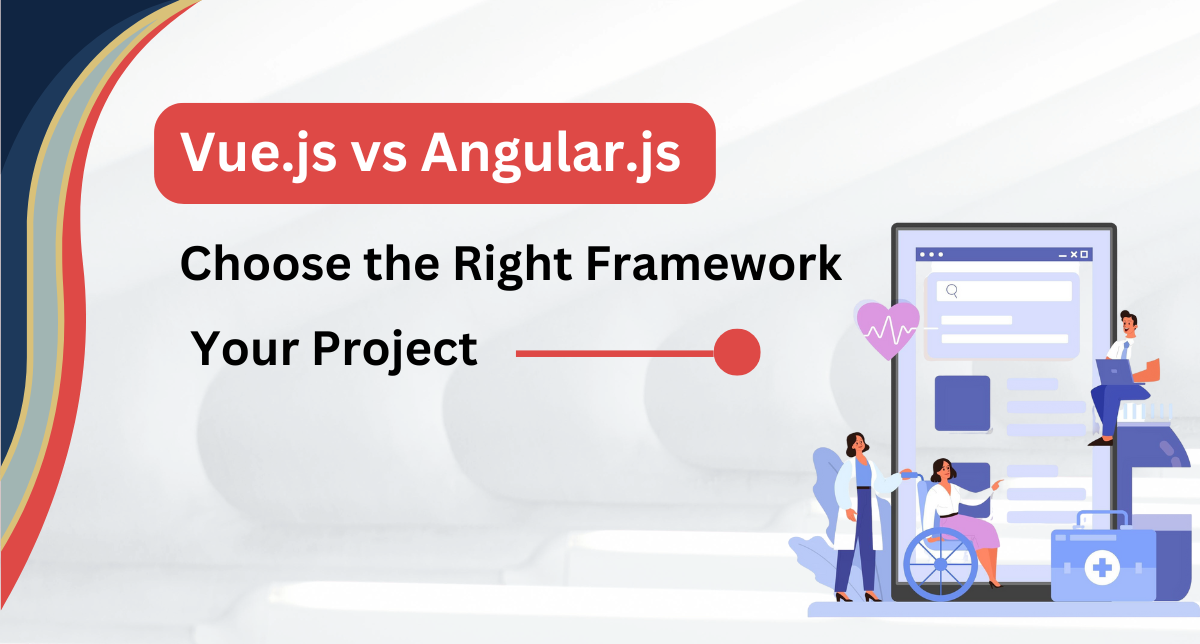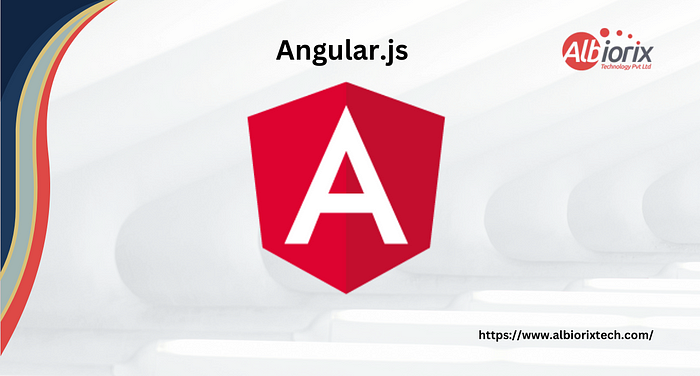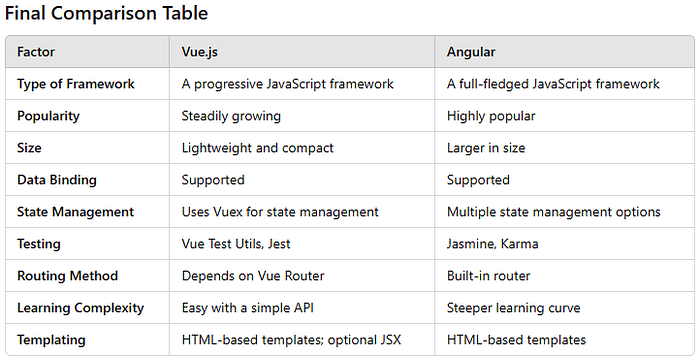
With the rapid advancement of front-end frameworks, selecting the ideal one for your project can be a challenging task. Vue.js and Angular are two such frameworks that often leave developers torn between their unique strengths and weaknesses. This blog is designed to simplify that decision-making process by offering a balanced comparison of these popular frameworks. Continue reading to make an informed choice for your next front-end development project.
Choosing the appropriate framework is a crucial step in web application development. For CTOs and project managers, the sheer number of options available can make this decision even more complex. Each framework offers distinct features and advantages, adding to the challenge of finding the perfect fit.
Among these choices, one of the most common debates is between Vue.js and Angular.js. Both frameworks are powerful tools for front-end development, but deciding which one is more suitable for your needs can be a tough call.
A detailed comparison of these frameworks can shed light on their key differences, advantages, and limitations. Gaining a deeper understanding of what each framework brings to the table will help you determine which one aligns best with your project requirements.
Let’s delve into this comprehensive comparison and explore which framework — Vue.js or Angular.js — might be the better choice for your development needs.
Vue.js vs AngularJS: A Brief Overview of Each Framework
Angular is a comprehensive, full-featured front-end web framework designed to build intricate web applications. It provides a strong foundation for developing single-page applications (SPAs), real-time apps, e-commerce platforms, and more, making it ideal for handling large-scale projects.
On the other hand, Vue.js is a lightweight and versatile framework that excels in creating modular, flexible single-page applications. It comes equipped with distinctive features such as computed properties, watchers, and a Virtual DOM, which give it an edge in simplicity and efficiency — features that are not available in Angular.
Here’s a closer look at each framework to understand their unique characteristics and strengths:
A Quick Overview of Vue.js

Vue.js
What is Vue.js?
Vue.js is a fast-growing JavaScript framework celebrated for its unique features. Developers often describe it as a performant, approachable, and highly adaptable tool for building modern web applications. It features a compiler-optimized and fully reactive rendering system, ensuring enhanced performance.
For developers familiar with HTML, CSS, and JavaScript, Vue.js is incredibly accessible, as it builds upon these core technologies. Its intuitive syntax and HTML-like templates make it easy to understand and implement, even for beginners.
Additionally, the Vue.js framework can function as a standalone library or integrate seamlessly with existing tech stacks, making it highly versatile for building complex web applications.
Key Features of Vue.js
Virtual DOM for improved speed and faster implementation of changes.
Reusable components that streamline development and enhance productivity.
The “v-on” directive enables event listening directly on DOM elements.
Built-in transition components make it easy to create elegant animations and effects.
Directives like v-for and v-bind simplify front-end development tasks.
Vue CLI provides tools for building and managing projects via a command-line interface.
Popular Web Applications Using Vue.js
GitLab
Behance
Grammarly
Font Awesome
Adobe
Habitica
Advantages of Vue.js
A gentle learning curve makes it beginner-friendly and quick to master.
As a lightweight framework, it improves SEO and enhances user experience.
The Virtual DOM ensures superior performance compared to many other frameworks.
Its reactivity system and data binding options enable the development of truly dynamic web applications.
Compatibility with standard HTML, CSS, and JavaScript allows for smooth integration with existing projects.
Disadvantages of Vue.js
Limited support and scalability for large-scale applications.
Resources are relatively fewer compared to more established frameworks.
A significant portion of its documentation is available in Chinese, posing a language barrier for some developers.
Build Scalable, Lightweight Web Applications with Vue.js for Optimal Performance
A Snapshot of Angular

Angular.js
Introduction to Angular
Angular is a popular choice among developers for building modern web applications. Developed and maintained by Google, it is a powerful JavaScript framework equipped with built-in libraries and tools to create scalable, feature-rich solutions.
Angular is based on TypeScript, which enhances its structure and maintainability. Features like component-based architecture, dependency injection, and two-way data binding make it a robust framework for crafting complex web applications.
With two-way data binding, the Angular framework ensures seamless synchronization between the data model and the user interface. Integrated testing capabilities further enable developers to build reliable and bug-free applications. The Angular CLI simplifies development, testing, and deployment, significantly speeding up the process.
Angular is a complete overhaul of its predecessor, AngularJS, introducing significant improvements like the adoption of TypeScript over JavaScript and a host of new features. As a result, Angular vs AngularJS have become distinct frameworks with unique capabilities.
Key Features of Angular
Command-Line Interface (CLI): Speeds up development and enhances productivity.
Two-Way Data Binding: Enables automatic synchronization between the model and the view.
Dependency Injection: Simplifies the management of dependencies across application components.
Advanced Animations: Supports the creation of dynamic and visually appealing user interfaces with minimal code.
Popular Applications Built with Angular
Forbes
Gmail
PayPal
Google
Upwork
Microsoft Office
Advantages of Angular
TypeScript and object-oriented programming principles ensure a modular and optimized codebase.
Developer-friendly tools like Angular CLI, Dart, Karma test runner, and Lambda operators streamline the development process.
Hierarchical dependency injection isolates application sections, making them easier to manage.
Built-in support for routing simplifies navigation within applications.
Disadvantages of Angular
Angular can be overly complex for smaller or simpler applications.
Browser compatibility issues may arise in certain scenarios.
Build Scalable, Feature-Rich Applications with Angular for Long-Term Success
Angular vs Vue: A Comprehensive Comparison
Angular and Vue share several similarities but also have distinct differences that set them apart. Both are widely recognized frontend web development frameworks, yet they cater to different project needs and development styles. Below is a detailed comparison highlighting the key differences between these frameworks.
1. Popularity
Developer Preferences and Framework Rankings
According to the StackOverflow Developer Survey 2024, Vue.js ranks eighth, while Angular holds the sixth position among the most favored web frameworks by developers.
Additionally, Angular garners more recognition on GitHub, with 95.7k stars, compared to Vue’s 46.7k stars. Angular’s popularity lies in its use for enterprise-scale applications, while Vue is often the preferred choice for smaller projects due to its simplicity and flexibility.
Angular boasts a well-established and extensive community that provides abundant resources, making it easier for developers to learn and troubleshoot issues. In contrast, Vue’s community is comparatively smaller but rapidly growing.
Interestingly, the survey also reveals that 60.2% of developers admire Vue, whereas 53.4% admire Angular. Furthermore, 16.3% of developers expressed interest in working with Vue, compared to 13.9% for Angular. This indicates a notable rise in Vue’s popularity and adoption in recent years.
For a visual comparison, refer to the developer preference chart.
Both frameworks have their strengths and fanbases, but the choice ultimately depends on the scale and requirements of the project.
2. Performance
When it comes to performance, Vue.js stands out, particularly for its faster initial page load time. Thanks to its smaller bundle size and simplified application structure, Vue delivers an excellent user experience, especially on slower networks.
Vue’s reactivity system ensures efficient DOM updates by modifying only the components affected by changes in state (such as data or props). This approach, combined with its use of Virtual DOM, allows Vue to render smooth and responsive UI updates, enhancing both performance and user experience.
However, as Vue applications scale with the addition of more features and components, performance might become unpredictable. This can impact application load time in certain scenarios.
Angular, on the other hand, offers robust performance optimizations with its Ivy rendering pipeline and other advanced techniques. Its ahead-of-time (AOT) compilation minimizes bundle size and pre-compile templates, ensuring faster runtime performance and initial loading.
While Angular traditionally used “Zones” for tracking and updating UI changes, the release of Angular v18 introduced significant improvements, streamlining the process and boosting performance. Additionally, Angular supports techniques like lazy loading and code splitting, which further optimize the initial load time for large applications.
For a detailed look, refer to the Vue and Angular performance benchmarks, which compare these frameworks across various metrics.
3. Learning Curve
When it comes to ease of learning, Vue.js takes the lead due to its clean, straightforward, and concise syntax. Many developers consider Vue the most beginner-friendly framework among JavaScript options. Its intuitive structure allows developers to create components using a blend of HTML and JavaScript, which feels familiar and natural.
Example of Vue Code
Vue’s simplicity helps reduce complexity when developing large-scale applications, making it an attractive choice for developers. This ease of use is a key reason why many choose Vue.js for application development.
On the other hand, Angular presents a steeper learning curve, particularly for beginners. Unlike Vue, learning Angular requires familiarity with TypeScript, a superset of JavaScript, which adds an additional layer of complexity.
Furthermore, Angular developers need to grasp advanced concepts like directives, pipes, RxJs, and standalone components to effectively use the framework.
Example of Angular Code
Despite its steeper learning curve, Angular provides the tools and capabilities to build highly scalable applications with advanced functionalities.
Learn how to build scalable applications with Angular.js to give your business a competitive edge: Upscale Your Business with Angular
4. Code Maintainability
When evaluating Vue.js and Angular for code maintainability, it’s essential to consider how a framework simplifies the process of managing and maintaining code. This aspect plays a crucial role in ensuring cost-efficient and high-quality web applications.
Angular promotes coding consistency through its CLI and a well-defined documentation style guide. It uses the POJO (Plain Old JavaScript Object) model, enabling developers to manipulate objects using standard JavaScript. This approach results in a structured and independent codebase, making Angular applications easier to maintain.
On the other hand, Vue.js is gaining traction as a reliable framework, although its growing ecosystem introduces some unpredictability. That said, Vue offers excellent documentation and style guidelines, which help streamline development and support maintainability. Developers often find Vue.js a great option for building manageable applications.
5. Scalability
For scalability, Vue.js is a lightweight framework that excels in small-scale projects. While it offers flexible tools to scale applications, achieving scalability can be challenging due to its architecture. The tight coupling of logic with UI components can make managing larger applications more complex. However, tools like Mixins and Web pack can help enhance scalability in Vue-based projects.
In contrast, Angular is a robust framework designed to handle enterprise-level applications. Its flexibility and scalability make it an excellent choice for growing businesses. Angular provides a scalable project structure by organizing code into modules and folders based on logical units. This modularity allows for easy expansion of features and components to accommodate larger applications.
6. Architecture
Vue.js follows the MVVM (Model-View-View Model) architectural pattern, dividing an application into three layers:
View: Handles user interface aspects like HTML templates, CSS styling, and user interactions. Vue’s declarative syntax helps define UI layouts and structures.
Model: Manages the application’s business logic and data, including inputs from users, APIs, or other sources. It typically consists of JavaScript objects or arrays.
ViewModel: Acts as a bridge between the View and Model, managing the logic and data necessary for rendering the UI.
In comparison, Angular adopts the MVC (Model-View-Controller) architecture, which also separates concerns into three distinct components:
Model: Contains the application’s data and business logic.
View: Represents the presentation layer, rendering the user interface.
Controller: Mediates interactions between the Model and View, coordinating logic and communication.
While both frameworks aim to simplify application structure, Angular’s MVC approach often suits larger, more complex projects, whereas Vue’s MVVM is better for smaller and medium-scale applications.

Vue.JS vs Angular: Final Thoughts
Both Vue.js and Angular are powerful frameworks, each with unique advantages and limitations. The decision to use one over the other ultimately depends on the specific requirements of your project.
For smaller projects that demand a lightweight structure and optimized rendering, Vue.js is an excellent choice. You can consider hiring a VueJS developer to create simple yet effective web applications.
For larger, more complex projects, Angular is the preferred framework. Its extensive tools and features enable the development of advanced and scalable applications.
If you’re looking to build exceptional web solutions using Vue.js or Angular, get in touch with us for a consultation. Let’s discuss your project and create a top-tier application tailored to your needs.





Write a comment ...